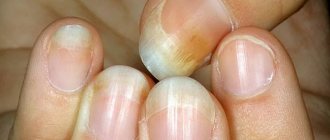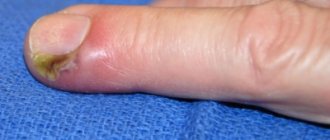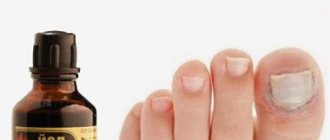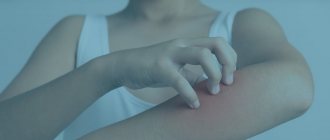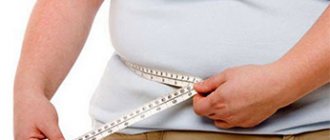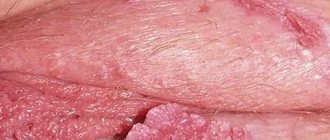Dermatovenerologist
Khasanova
Alina Rashidovna
9 years experience
Make an appointment
Nail onycholysis is a dystrophic lesion of the nail plate, manifested in its separation from the bed while partially or completely maintaining its usual shape. Pathology develops with equal frequency on the fingers or toes. About 60% of detected cases of the disease are the consequences of injuries, up to 30% are formed under the influence of dermatomycosis. The remaining 10% are due to somatic diseases, dermatoses or pyoderma. The disease can develop in a person at any age; women are diagnosed more often than men. In case of traumatic damage to the nail, the pathology does not cause significant discomfort to the wearer; treatment is carried out for aesthetic reasons.
Reasons for development
Dermatologists distinguish three groups of causes for the development of the disease:
- injuries;
- mycoses;
- allergies.
The mechanism of development of onycholysis on the fingers is determined by the root cause of the pathology.
Traumatic injuries to the hands or feet affect the nails and nail bed. A subungual hematoma is formed between them, the vessels in the upper layers of the dermis are compressed, which leads to disruption of the nutrition of the nail, a change in its chemical composition and loss of elasticity. The plate is deformed, the connection between it and the bed weakens. Detachment occurs from the free edge. Violation of the fit increases the risk of infection and the development of inflammation. The nail root does not lose connection with the matrix. After the hematoma resolves, the plate grows as before.
Infectious onycholysis on the arms or legs occurs due to inflammation. The process includes three stages:
- alteration - pathological damage to the dermis, cells of the immune system produce cytokines and inflammatory mediators;
- exudation - disturbance of water-electrolyte balance in tissues, swelling of the nail, development of pathogenic microflora on the bed;
- proliferation - the development of hyperkeratosis of the nail bed with its subsequent deformation.
Normal growth of the nail plate begins after complete relief of the inflammatory process. Complicated onycholysis of fingernails or toenails will require the patient not only to comply with all medical prescriptions of the dermatologist, but also to follow a diet.
The allergic variant of the pathology develops according to a similar scenario to the inflammatory one. During the exudation stage, an excess amount of antibodies to pathogenic microflora is produced. This leads to increased sensitivity of the skin, increased deformation of the nail plate and the adjacent dermis. The regeneration process slows down significantly.
Causes and risk factors
The etiology of the disease is based on infection of the nails by pathogenic fungi, including:
- dermatophytes (T. rubrum, T. interdigitale);
- yeast of the genus Candida (C. aibicans, C. tropicalis);
- mold fungi (Fusaria, Alternaria).
In addition to the main cause of the disease, there are a number of predisposing factors that increase the risk of developing onychomycosis. The trigger for the activation of a fungal infection can be:
- lack of nail care;
- diabetes;
- varicose veins;
- obesity;
- injuries;
- wearing tight shoes;
- poor quality pedicure;
- taking potent drugs.
Particular attention in the development of the disease is given to the state of the immune system. With strong immunity, the human body will be able to resist pathogenic flora even after it penetrates the body, but if immunity is reduced, fungal mycelium easily penetrates the epithelium of the nail, which causes inflammatory and dystrophic changes.
Nail fungus should not be considered as an aesthetic problem, since the toxins released by fungi can spread throughout the entire body and cause a number of concomitant diseases.
Photo: Symptoms of fungal nail infection
Kinds
Dermatologists distinguish several main types of pathology based on the clinical picture of the disease and the cause of damage to the patient’s nail plates. The most common types of onycholysis are:
- traumatic;
- dermatological;
- endocrine;
- systemic;
- fungal;
- bacterial;
- allergic.
Traumatic lesions of the nails occur after wounds or burns to the patient’s tissues. Probable causes remain splinters, excessive physical impact, and exposure to toxic or toxic substances. Toes can be hurt when wearing tight or poorly ventilated shoes.
The dermatological type of pathology develops under the influence of dermatoses, leading to disturbances in the processes of cellular nutrition in the affected area. Endocrine onycholysis results from humoral disorders in the human body or chronic disorders of the endocrine glands.
Systemic onycholysis is caused by diseases of the human digestive tract and subsequent metabolic disorders. The condition of the patient's tissues improves significantly after eliminating the disease that is the root cause of the separation of the nails from the bed.
The fungal type of pathology is formed after the formation of colonies of microfungi in the subungual space. The subsequent change in the nail bed almost does not affect the nail itself, which remains unchanged. The disease develops as a result of a long-term mycotic infection.
The bacterial course of onycholysis is the result of the addition of a secondary infection to any type of pathology. Allergic lesions of nail tissue develop when the patient takes medications, contacts with chemicals or directed ultraviolet radiation.
Why does a cavity form under the fingernail:
- nail injury;
- chemical burns resulting from the use of low-quality gel polishes or from contact with household chemicals and other aggressive substances;
- thinning of nails as a result of self-removal of artificial coating or sawing of the nail plate with a file (cutter) by a master;
- onychophagia, or a mental disorder in which a person bites or picks at the nail beds and the skin around them. As a result, the nail peels off from the nail bed;
- attempts to move the hyponychium or clean out dirt under the nails with something sharp;
- dermatological pathologies.
If you notice the first symptoms of onycholysis, contact the PODOLAB Podology Center in St. Petersburg. Podologists will advise you on this problem. And you will quickly restore the attractive appearance of your nails.
Symptoms on arms and legs
The clinical picture of the disease is the same for all types of pathology: the nail plate is separated from the bed from the free edge in the distal or lateral sections to the nail hole. The color of the plate changes from flesh-colored to gray-white due to air entering the subungual space. With the development of pathogenic microflora in the resulting free space, a further change in color is possible: yellow becomes the result of bacterial infections, brown - the formation of a colony of microfungi, green - damage to Pseudomonas aeruginosa.
Bacterial infections affect the structure and strength of the nail plate. The surface of the nails loses its shine, becomes rough and gradually becomes deformed. The subungual space is filled with dirt and keratin. This leads to the development of hyperkeratosis, characterized by an unpleasant odor. In advanced stages of the pathology, a focus of secondary inflammation may develop. Detachment of part of the nail is called partial onycholysis, while the entire plate is called total.
Diagnosis of the disease
It is easy to diagnose onycholysis based on clinical manifestations:
- the nail plate acquires a bluish color with tints of red and yellow;
- a void appears in any location of the nail under the plate (sometimes the visual impression is such that the nail in this place seems to have risen above the bed);
- at the site of detachment, the nail plate loses its natural elasticity, which is felt when cutting the nail during manicure and pedicure.
In this case, detachment of the nail plate can be:
- partial;
- complete (when the nail is held on the bed only by “fastening” along its edges).
Seeing a doctor
Detecting the first symptoms of onycholysis is a good reason to visit the clinic. Any stage of the disease requires consultation with a dermatologist. During the diagnosis and treatment of the disease, the patient may require the opinions of other specialists: an endocrinologist, a surgeon, a therapist.
Ignoring the symptoms of pathology can lead to multiple damage to the nail plates on the patient’s hands and feet, the formation of numerous foci of infection and damage to other tissues and systems of the body.
Are you experiencing symptoms of onycholysis?
Only a doctor can accurately diagnose the disease. Don't delay your consultation - call
Diagnostics on legs and arms
The diagnosis is made during a visual examination of the patient by a dermatologist. The development of onycholysis is preceded by damage to the nail plates by Bo lines, which occur against the background of damage to the nail matrix. This sign indicates systematic injuries or the presence of somatic pathologies.
A mandatory stage of clinical tests is obtaining scrapings from damaged tissues to conduct laboratory tests and exclude mycotic lesions of the nail and nail bed. Differential diagnosis of onycholysis is carried out with mycoses, psoriasis, lichen planus, Bowen's disease and onychodystrophies of unknown etiology.
Different types of onycholysis on the fingers or toes will require in-depth analyzes to establish the causes of the development of pathology with multiple clinical pictures. The reason for this is the variety of colors of the nail plates, visible differences in their structure, transparency, and area of hyperkeratotic layering.
Clinical signs
Normally, the nail plate is smooth and even, but as a fungal infection develops, its structure is disrupted and its appearance deteriorates. Onychomycosis is a slowly progressive disease. The first signs of the disease are not observed immediately after contact with the pathogen, but after a while, when fungal spores penetrate deep tissues.
Onychomycosis can be recognized by the following signs:
- itching and burning in the interdigital areas;
- small skin cracks on the fingers;
- severe sweating of the feet;
- peeling of the periungual platinum;
- unpleasant odor;
- skin redness;
- thickening of the nail;
- dullness, yellowness and roughness.
Pathological changes are present not only on the nails, but also on the skin of the feet, especially between the fingers and toes.
In dermatology, there are three main stages of onychomycosis:
- Normotrophic type - the disease often goes unnoticed, which leads to its progression. You may notice minor spots or stripes on the nails, it loses its shine, may change its thickness, and itching and burning appear.
- Hypertrophic onychomycosis - there is thickening and deformation of the nail, bird's claw syndrome.
- Atrophic - destruction of the nail plate, the nail moves away from the bed. The only treatment for the atrophic form of the disease is nail removal.
When nails are deeply damaged, the infection penetrates the bloodstream and significantly reduces the functioning of the immune system, thereby increasing the risk of developing other diseases.
Photo: Stages of onychomycosis
Treatment of nail onycholysis
Pathology requires complex therapy. The key task is to treat the underlying disease against which onycholysis of the nails develops. The allergic type of damage to the nail plate requires consultation of the patient with a nutritionist or gastroenterologist to adjust the functioning of the digestive system through diet. Correcting the imbalance of minerals and vitamins will reduce the likelihood of further progression of onycholysis.
The traumatic type of pathology involves daily removal of the growing tissue of the exfoliated area, followed by disinfection of the subungual space and protection of the bed with an antibacterial patch.
Large area detachments are treated surgically. After removing the nail plate, antibacterial and antiseptic dressings are applied to the bed. The operation allows surgeons to remove hyperkeratotic deposits, dirt and the consequences of hematoma development. Nail restoration is carried out using gelatin solutions of various concentrations.
Bacterial and mycotic lesions of the nail are treated with alcohol solutions of aniline paints, antibacterial and antifungal drugs.
Effective Treatments for Fungal Nail Infection
Treatment of onychomycosis is a rather long process, which consists of complex therapy. Modern dermatology provides several effective methods to get rid of onychomycosis. In practice, they most often use:
- systemic antimicrobial and antifungal drugs;
- local antimycotics;
- physiotherapy;
- hardware cosmetology;
- folk remedies;
- surgery to remove a diseased nail.
To achieve the maximum therapeutic effect, in addition to the main treatment, it is important to monitor the hygiene of your feet and nails.
Pharmacy drugs
Modern pharmacology provides a fairly large range of medications that can cure nail fungus. They are produced by different manufacturers in different forms and have different prices. In therapy, drugs with systemic and symptomatic action are more often used. In the first case, the medicine has a detrimental effect on pathogenic fungal pathogens, destroys their cellular structure, and prevents further reproduction and spread. Symptomatic drugs relieve symptoms, relieve itching, peeling, and improve the appearance of the nail.
Treatment of onychomycosis can take from 3 to 6 months, and sometimes more than a year, and there is always a risk of re-infection.
The most effective remedy is etiotropic therapy, which consists of the use of tablets, capsules, local medications - ointments, gels, varnishes.
In practice, antifungal tablets are most often used:
- Ketoconazole.
- Lamisil.
- Fluconazole.
- Griseofulvin.
The active components of such drugs destroy pathogenic fungal flora, block the growth and reproduction of pathogens. Only a doctor can prescribe them individually for each patient.
Local drugs act at the source of inflammation, relieve symptoms, and destroy pathogenic fungal flora:
- Nizoral cream.
- Lac Loceryl.
- Lamisil ointment or spray.
- Mycozoral ointment.
- Fukortsin, Kreolin - solutions for treating nails.
If nail fungus is diagnosed and treated with inexpensive but effective drugs, you need to pay attention to the products of domestic pharmacological companies, the cost of which is several times lower than that of foreign drugs. At the same time, the effect of treatment is similar to expensive drugs.
At the initial stages of the disease or in combination with other treatment methods, a good effect can be obtained from keratolytic agents:
- Set of Mycospores.
- Onychoplast.
- Salipod.
- Ureaplast.
They are produced in the form of a patch, which, after steaming, is glued to the diseased nail. They must be used in accordance with the instructions for use.
Important: After treatment has been completed and the symptoms of the disease have been eliminated, the risk of relapse will always be present, so you need to keep your feet clean and periodically use ointments to prevent recurrence of the disease.
Photo: Drugs for the treatment of onychomycosis
Physiotherapy
Physiotherapeutic treatment of onychomycosis will speed up the recovery period, improve blood circulation, and enhance the growth of healthy tissues. Efficiency has:
- diathermy;
- amplipulse therapy;
- laser treatment;
- paraffin applications;
- darsonvalization;
- magnetotherapy.
Such procedures are prescribed in short courses - up to 10 days.
Folk remedies
Traditional medicine comes to the aid of traditional therapy. Various herbs, improvised remedies, and essential oils are used as medicinal raw materials. Let's look at a few effective recipes:
Soda bath. It has an antimicrobial effect, destroys pathogenic fungal parasites, eliminates unpleasant odor, and allows you to soften the nail before removing it. To prepare, you need to dilute 2 tablespoons of soda in 2 liters of warm water, stir well and keep your feet on for 10 - 15 minutes.
Iodine. A powerful antiseptic that allows you to destroy pathogenic fungal flora. You need to apply the iodine solution to the sore nail, without touching the skin, once every 2 days.
Essential oils. You can get rid of onychomycosis using lavender or tea tree essential oils. It is enough to apply pure oil to the nail using a cotton swab. It is recommended to carry out the procedure before bedtime.
Calamus root. To prepare the medicine, you need to take 30 g of calamus root, pour boiling water, and put on low heat for 5 minutes. Then leave for 1 hour, strain. The resulting decoction can be used to treat nail plates or take 50 ml orally, after diluting it with water 1:1. Treatment should be continued for about 2 weeks.
When using any remedy for toenail fungus, you need to make sure there is no allergy.
Alternative medicine is not a panacea, but still, as a means of prevention or in the initial stages of the disease, it has a good therapeutic effect.
If there is no effect from conservative therapy or the disease is advanced, the doctor prescribes surgery to remove the nail plate. Its implementation will reduce the intake of medications and speed up the recovery period.
Photo: Soda baths in the treatment of nail fungus.
Make an appointment
You can make an appointment with the specialists of JSC "Medicine" (clinic of Academician Roitberg) on the website - the interactive form allows you to select a doctor by specialization or search for an employee of any department by name and surname. Each doctor’s schedule contains information about visiting days and hours available for patient visits.
Clinic administrators are ready to accept requests for an appointment or call a doctor at home by calling +7 (495) 775-73-60.
Convenient location on the territory of the central administrative district of Moscow (CAO) - 2nd Tverskoy-Yamskaya lane, building 10 - allows you to quickly reach the clinic from the Mayakovskaya, Novoslobodskaya, Tverskaya, Chekhovskaya and Belorusskaya metro stations .
